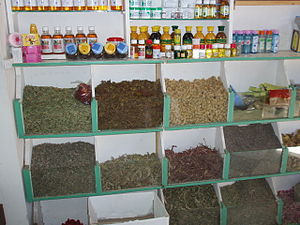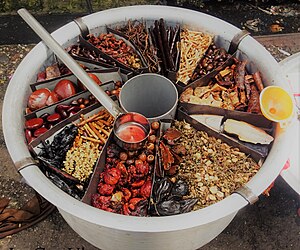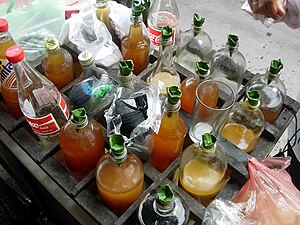Herbal medicine/ja: Difference between revisions
Created page with "==動物による植物の利用== {{Anchor|Use of plants by animals}} {{main/ja|Zoopharmacognosy/ja}}" |
|||
| Line 217: | Line 217: | ||
{{main/ja|Zoopharmacognosy/ja}} | {{main/ja|Zoopharmacognosy/ja}} | ||
先住民のヒーラーはしばしば、病気の動物が普段は拒絶するはずの苦いハーブをかじるように食物の嗜好を変えることを観察して学んだと主張する。野外生物学者たちは、ニワトリ、ヒツジ、[[butterfly/ja|蝶]]、[[chimpanzee/ja|チンパンジー]]などの多様な種の観察に基づく裏付けとなる証拠を提供している。食事を変える習慣は、腸内寄生虫を浄化する物理的手段であることが示されている。病気の動物は[[tannins/ja|タンニン]]や[[alkaloids/ja|アルカロイド]]などの[[secondary metabolites/ja|二次代謝産物]]を豊富に含む植物を採食する傾向がある。 | |||
== こちらも参照 == | == こちらも参照 == | ||
Revision as of 14:59, 17 March 2024
| この記事は、下記シリーズの一部分 |
| Alternative medicine/ja |
|---|
 |

本草学(ほんぞうがく、herbal medicine, herbalism)とは、伝統医学の基礎となる生薬学と薬用植物の利用の学問である。世界的な薬理学の研究により、アルテミシア・アンヌア(漢方では解熱薬として知られていた薬草)から単離されたアルテミシニンと呼ばれる抗マラリア薬物のように、本草学が現代薬に転用されたものもある。21世紀の本草学で使用される植物の安全性と有効性に関する科学的根拠は限られており、一般的に純度や用量の基準は示されていない。本草学の範囲には、一般的に菌類や蜂の産物、鉱物、貝殻、特定の動物の部位が含まれる。本草学は植物医学または植物療法とも呼ばれる。
パラハーバリズム (Paraherbalism)とは、代替医療や疑似科学において、精製されていない植物や動物のエキスを、実証されていない医薬品や健康増進剤として使用することを指す。パラハーバリズムは、より少ない加工で特定の供給源から様々な物質を保存することは、製造された製品よりも安全であるか、より効果的であるという信念に依存しているが、この概念には根拠がない。
歴史

考古学的証拠によれば、薬用植物の使用は約6万年前の旧石器時代にまでさかのぼる。薬草療法の文字による証拠は5,000年以上前のシュメール人に遡り、彼らは植物のリストをまとめた。いくつかの古代文化では、薬草書と呼ばれる書物に植物とその医療用途について書かれている。古代エジプトでは、ハーブはエジプト医学パピルスに記載されていたり、墓の挿絵に描かれていたり、まれに微量のハーブが入った医療用の壺から発見されたりする。古代エジプトのエベルス・パピルスは紀元前1550年頃のもので、主に植物由来の700以上の化合物を扱っている。最古のギリシア語の薬草書は、紀元前4世紀にギリシア語で著したエレソスのテオフラストスのHistoria Plantarum、紀元前3世紀に著したカリストスのディオクレス、紀元前1世紀に著したクラテュアスのものである。これらの著作の断片はわずかしか残っていないが、残っているものから、学者たちはエジプトの本草書との重複を指摘した。薬草学に用いられたと思われる種子が青銅器時代の中国の遺跡から発見された。中国の殷王朝(紀元前1600〜1046年頃)の遺跡から、薬草学に用いられたと思われる種子が発見された。中国初期の医学書である『黄帝内経』に記載されている224種類の化合物のうち100種類以上が医薬品である。ハーブは古代インドの伝統医学でもよく使われており、そこでは病気の主な治療法は食事療法であった。アナザルバス キリキア,ペダニウス・ディオスコリデス(紀元後40-90年頃)がギリシャ語で書いたデ・マテリア・メディカは、医師であり植物学者であったが、1600年代まで何世紀にもわたって使用された薬草書の一例である。
現代の本草学
世界保健機関(WHO)の推計によれば、現在、アジアやアフリカのいくつかの国では、人口の80%がプライマリーヘルスケアのために本草学を利用している。
処方薬の中には、アルテミシニン、ジギタリス、キニーネ、タキサンなど、漢方薬としての基礎を持っているものもある。
規制の見直し
2015年、オーストラリア保健省は、代替療法が健康保険の適用に適しているかどうかを判断するためのレビュー結果を発表した。ハーブ製品の安全性と有効性を評価するためのガイドラインを確立するために、欧州医薬品庁は2017年にハーブ製品に関するモノグラフを作成する際の臨床研究の質を評価・格付けするための基準を示した。米国では、国立衛生研究所の国立補完統合医療センターがハーブ化合物の臨床試験に資金を提供し、多くの植物源の安全性、潜在的有効性、副作用を評価するファクトシートを提供し、ハーブ製品について実施された臨床研究の登録簿を管理している。
2015年時点の英国がん研究によれば、「ハーブ療法ががんを治療、予防、治癒できるという強力な証拠は、現在のところ人を対象とした研究からは得られていない」という。
使用頻度
漢方薬の使用は、がん、糖尿病、喘息、末期腎臓病などの慢性疾患を持つ人々により多くみられる。また、性別、年齢、民族性、教育、社会階層といった複数の要因が、漢方薬の使用率と関連していることが示されている。
Herbal preparations

There are many forms in which herbs can be administered, the most common of which is a liquid consumed as a herbal tea or a (possibly diluted) plant extract.
Herbal teas, or tisanes, are the resultant liquid of extracting herbs into water, though they are made in a few different ways. Infusions are hot water extracts of herbs, such as chamomile or mint, through steeping. Decoctions are the long-term boiled extracts, usually of harder substances like roots or bark. Maceration is the cold infusion of plants with high mucilage-content, such as sage or thyme. To make macerates, plants are chopped and added to cold water. They are then left to stand for 7 to 12 hours (depending on herb used). For most macerates, 10 hours is used.
Tinctures are alcoholic extracts of herbs, which are generally stronger than herbal teas. Tinctures are usually obtained by combining pure ethanol (or a mixture of pure ethanol with water) with the herb. A completed tincture has an ethanol percentage of at least 25% (sometimes up to 90%). Non-alcoholic tinctures can be made with glycerin but it is believed to be less absorbed by the body than alcohol based tinctures and has a shorter shelf life. Herbal wine and elixirs are alcoholic extract of herbs, usually with an ethanol percentage of 12–38%. Extracts include liquid extracts, dry extracts, and nebulisates. Liquid extracts are liquids with a lower ethanol percentage than tinctures. They are usually made by vacuum distilling tinctures. Dry extracts are extracts of plant material that are evaporated into a dry mass. They can then be further refined to a capsule or tablet.
The exact composition of an herbal product is influenced by the method of extraction. A tea will be rich in polar components because water is a polar solvent. Oil on the other hand is a non-polar solvent and it will absorb non-polar compounds. Alcohol lies somewhere in between.

Many herbs are applied topically to the skin in a variety of forms. Essential oil extracts can be applied to the skin, usually diluted in a carrier oil. Many essential oils can burn the skin or are simply too high dose used straight; diluting them in olive oil or another food grade oil such as almond oil can allow these to be used safely as a topical. Salves, oils, balms, creams, and lotions are other forms of topical delivery mechanisms. Most topical applications are oil extractions of herbs. Taking a food grade oil and soaking herbs in it for anywhere from weeks to months allows certain phytochemicals to be extracted into the oil. This oil can then be made into salves, creams, lotions, or simply used as an oil for topical application. Many massage oils, antibacterial salves, and wound healing compounds are made this way.
Inhalation, as in aromatherapy, can be used as a treatment.
Safety

Consumption of herbs may cause adverse effects. Furthermore, "adulteration, inappropriate formulation, or lack of understanding of plant and drug interactions have led to adverse reactions that are sometimes life threatening or lethal." Proper double-blind clinical trials are needed to determine the safety and efficacy of each plant before medical use.
Although many consumers believe that herbal medicines are safe because they are natural, herbal medicines and synthetic drugs may interact, causing toxicity to the consumer. Herbal remedies can also be dangerously contaminated, and herbal medicines without established efficacy, may unknowingly be used to replace prescription medicines.
Standardization of purity and dosage is not mandated in the United States, but even products made to the same specification may differ as a result of biochemical variations within a species of plant. Plants have chemical defense mechanisms against predators that can have adverse or lethal effects on humans. Examples of highly toxic herbs include poison hemlock and nightshade. They are not marketed to the public as herbs, because the risks are well known, partly due to a long and colorful history in Europe, associated with "sorcery", "magic" and intrigue. Although not frequent, adverse reactions have been reported for herbs in widespread use. On occasion serious untoward outcomes have been linked to herb consumption. A case of major potassium depletion has been attributed to chronic licorice ingestion, and consequently professional herbalists avoid the use of licorice where they recognize that this may be a risk. Black cohosh has been implicated in a case of liver failure. Few studies are available on the safety of herbs for pregnant women, and one study found that use of complementary and alternative medicines are associated with a 30% lower ongoing pregnancy and live birth rate during fertility treatment.
Examples of herbal treatments with likely cause-effect relationships with adverse events include aconite (which is often a legally restricted herb), Ayurvedic remedies, broom, chaparral, Chinese herb mixtures, comfrey, herbs containing certain flavonoids, germander, guar gum, liquorice root, and pennyroyal. Examples of herbs that may have long-term adverse effects include ginseng, the endangered herb goldenseal, milk thistle, senna (against which herbalists generally advise and rarely use), aloe vera juice, buckthorn bark and berry, cascara sagrada bark, saw palmetto, valerian, kava (which is banned in the European Union), St. John's wort, khat, betel nut, the restricted herb ephedra, and guarana.
There is also concern with respect to the numerous well-established interactions of herbs and drugs. In consultation with a physician, usage of herbal remedies should be clarified, as some herbal remedies have the potential to cause adverse drug interactions when used in combination with various prescription and over-the-counter pharmaceuticals, just as a customer should inform a herbalist of their consumption of actual prescription and other medication.
For example, dangerously low blood pressure may result from the combination of an herbal remedy that lowers blood pressure together with prescription medicine that has the same effect. Some herbs may amplify the effects of anticoagulants. Certain herbs as well as common fruit interfere with cytochrome P450, an enzyme critical to much drug metabolism.
In a 2018 study, FDA identified active pharmaceutical additives in over 700 of analyzed dietary supplements sold as "herbal", "natural" or "traditional". The undisclosed additives included "unapproved antidepressants and designer steroids", as well as prescription drugs, such as sildenafil or sibutramine.
Labeling accuracy
A 2013 study found that one-third of herbal supplements sampled contained no trace of the herb listed on the label. The study found products adulterated with contaminants or fillers not listed on the label, including potential allergens such as soy, wheat, or black walnut. One bottle labeled as St. John's wort was found to actually contain Alexandrian senna, a laxative.
Researchers at the University of Adelaide found in 2014 that almost 20 percent of herbal remedies surveyed were not registered with the Therapeutic Goods Administration, despite this being a condition for their sale. They also found that nearly 60 percent of products surveyed had ingredients that did not match what was on the label. Out of 121 products, only 15 had ingredients that matched their TGA listing and packaging.
In 2015, the New York Attorney General issued cease and desist letters to four major U.S. retailers (GNC, Target, Walgreens, and Walmart) who were accused of selling herbal supplements that were mislabeled and potentially dangerous. Twenty-four products were tested by DNA barcoding as part of the investigation, with all but five containing DNA that did not match the product labels.
Practitioners of herbalism

In some countries, formalized training and minimum education standards exist for herbalists, although these are not necessarily uniform within or between countries. In Australia, for example, the self-regulated status of the profession (as of 2009) resulted in variable standards of training, and numerous loosely formed associations setting different educational standards. One 2009 review concluded that regulation of herbalists in Australia was needed to reduce the risk of interaction of herbal medicines with prescription drugs, to implement clinical guidelines and prescription of herbal products, and to assure self-regulation for protection of public health and safety. In the United Kingdom, the training of herbalists is done by state-funded universities offering Bachelor of Science degrees in herbal medicine. In the United States, according to the American Herbalist Guild, "there is currently no licensing or certification for herbalists in any state that precludes the rights of anyone to use, dispense, or recommend herbs." However, there are U.S. federal restrictions for marketing herbs as cures for medical conditions, or essentially practicing as an unlicensed physician.
United States herbalism fraud
Over the years 2017–21, the U.S. Food and Drug Administration (FDA) issued warning letters to numerous herbalism companies for illegally marketing products under "conditions that cause them to be drugs under section 201(g)(1) of the Act [21 U.S.C. § 321(g)(1)], because they are intended for use in the diagnosis, cure, mitigation, treatment, or prevention of disease and/or intended to affect the structure or any function of the body" when no such evidence existed. During the COVID-19 pandemic, the FDA and U.S. Federal Trade Commission issued warnings to several hundred American companies for promoting false claims that herbal products could prevent or treat COVID-19 disease.
Government regulations
The World Health Organization (WHO), the specialized agency of the United Nations (UN) that is concerned with international public health, published Quality control methods for medicinal plant materials in 1998 to support WHO Member States in establishing quality standards and specifications for herbal materials, within the overall context of quality assurance and control of herbal medicines.
In the European Union (EU), herbal medicines are regulated under the Committee on Herbal Medicinal Products.
In the United States, herbal remedies are regulated dietary supplements by the Food and Drug Administration (FDA) under current good manufacturing practice (cGMP) policy for dietary supplements. Manufacturers of products falling into this category are not required to prove the safety or efficacy of their product so long as they do not make 'medical' claims or imply uses other than as a 'dietary supplement', though the FDA may withdraw a product from sale should it prove harmful.
Canadian regulations are described by the Natural and Non-prescription Health Products Directorate which requires an eight-digit Natural Product Number or Homeopathic Medicine Number on the label of licensed herbal medicines or dietary supplements.
Some herbs, such as cannabis and coca, are outright banned in most countries though coca is legal in most of the South American countries where it is grown. The Cannabis plant is used as an herbal medicine, and as such is legal in some parts of the world. Since 2004, the sales of ephedra as a dietary supplement is prohibited in the United States by the FDA, and subject to Schedule III restrictions in the United Kingdom.
Scientific criticism
Herbalism has been criticized as a potential "minefield" of unreliable product quality, safety hazards, and potential for misleading health advice. Globally, there are no standards across various herbal products to authenticate their contents, safety or efficacy, and there is generally an absence of high-quality scientific research on product composition or effectiveness for anti-disease activity. Presumed claims of therapeutic benefit from herbal products, without rigorous evidence of efficacy and safety, receive skeptical views by scientists.
Unethical practices by some herbalists and manufacturers, which may include false advertising about health benefits on product labels or literature, and contamination or use of fillers during product preparation, may erode consumer confidence about services and products.
Paraherbalism

Paraherbalism is the pseudoscientific use of extracts of plant or animal origin as supposed medicines or health-promoting agents. Phytotherapy differs from plant-derived medicines in standard pharmacology because it does not isolate and standardize the compounds from a given plant believed to be biologically active. It relies on the false belief that preserving the complexity of substances from a given plant with less processing is safer and potentially more effective, for which there is no evidence either condition applies.
Phytochemical researcher Varro Eugene Tyler described paraherbalism as "faulty or inferior herbalism based on pseudoscience", using scientific terminology but lacking scientific evidence for safety and efficacy. Tyler listed ten fallacies that distinguished herbalism from paraherbalism, including claims that there is a conspiracy to suppress safe and effective herbs, herbs can not cause harm, that whole herbs are more effective than molecules isolated from the plants, herbs are superior to drugs, the doctrine of signatures (the belief that the shape of the plant indicates its function) is valid, dilution of substances increases their potency (a doctrine of the pseudoscience of homeopathy), astrological alignments are significant, animal testing is not appropriate to indicate human effects, anecdotal evidence is an effective means of proving a substance works and herbs were created by God to cure disease. Tyler suggests that none of these beliefs have any basis in fact.
Traditional systems

Africa
Up to 80% of the population in Africa uses traditional medicine as primary health care.
Americas
Native Americans used about 2,500 of the approximately 20,000 plant species that are native to North America.
In Andean healing practices, the use of Entheogens, in particular the San Pedro cactus (Echinopsis pachanoi) is still a vital component, and has been around for millennia.
China
Some researchers trained in both Western and traditional Chinese medicine have attempted to deconstruct ancient medical texts in the light of modern science. In 1972, Tu Youyou, a pharmaceutical chemist, extracted the anti-malarial drug artemisinin from sweet wormwood, a traditional Chinese treatment for intermittent fevers.
India

In India, Ayurvedic medicine has quite complex formulas with 30 or more ingredients, including a sizable number of ingredients that have undergone "alchemical processing", chosen to balance dosha. In Ladakh, Lahul-Spiti, and Tibet, the Tibetan Medical System is prevalent, also called the "Amichi Medical System". Over 337 species of medicinal plants have been documented by C.P. Kala. Those are used by Amchis, the practitioners of this medical system. The Indian book, Vedas, mentions treatment of diseases with plants.
Indonesia

In Indonesia, especially among the Javanese, the jamu traditional herbal medicine may have originated in the Mataram Kingdom era, some 1300 years ago. The bas-reliefs on Borobudur depict the image of people grinding herbs with stone mortar and pestle, a drink seller, an herbalist, and masseuse treating people. The Madhawapura inscription from Majapahit period mentioned a specific profession of herbs mixer and combiner (herbalist), called Acaraki. The book from Mataram dated from circa 1700 contains 3,000 entries of jamu herbal recipes, while Javanese classical literature Serat Centhini (1814) describes some jamu herbal concoction recipes.
Though possibly influenced by Indian Ayurveda systems, the Indonesia archipelago holds numerous indigenous plants not found in India, including plants similar to those in Australia beyond the Wallace Line. Jamu practices may vary from region to region, and are often not recorded, especially in remote areas of the country. Although primarily herbal, some Jamu materials are acquired from animals, such as honey, royal jelly, milk, and Ayam Kampung eggs.
Beliefs
Herbalists tend to use extracts from parts of plants, such as the roots or leaves, believing that plants are subject to environmental pressures and therefore develop resistance to threats such as radiation, reactive oxygen species and microbial attack to survive, providing defensive phytochemicals of use in herbalism.
動物による植物の利用
先住民のヒーラーはしばしば、病気の動物が普段は拒絶するはずの苦いハーブをかじるように食物の嗜好を変えることを観察して学んだと主張する。野外生物学者たちは、ニワトリ、ヒツジ、蝶、チンパンジーなどの多様な種の観察に基づく裏付けとなる証拠を提供している。食事を変える習慣は、腸内寄生虫を浄化する物理的手段であることが示されている。病気の動物はタンニンやアルカロイドなどの二次代謝産物を豊富に含む植物を採食する傾向がある。
こちらも参照
- 漢方薬
- Ethnobotany/ja
- Ethnomedicine/ja
- Herbal/ja
- Medicinal fungi/ja
- List of plants used in herbalism/ja
- 伝統医学
さらに読む
- Aronson JK (2008). Meyler's Side Effects of Herbal Medicines. Elsevier. ISBN 9780080932903.
- Braun L, Cohen M (2007). Herbs and Natural Supplements: An Evidence-Based Guide. Elsevier. ISBN 9780729537964.

